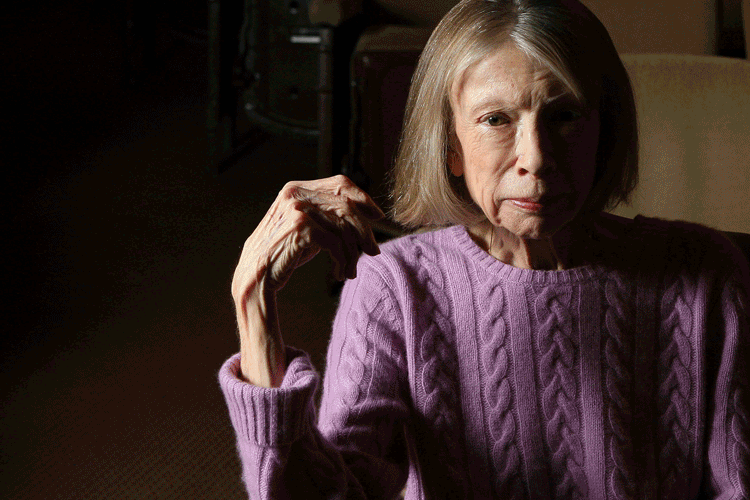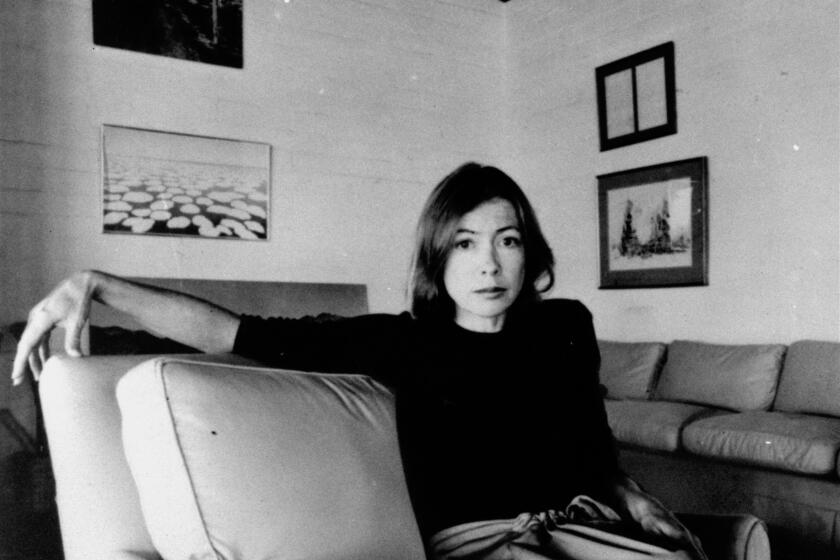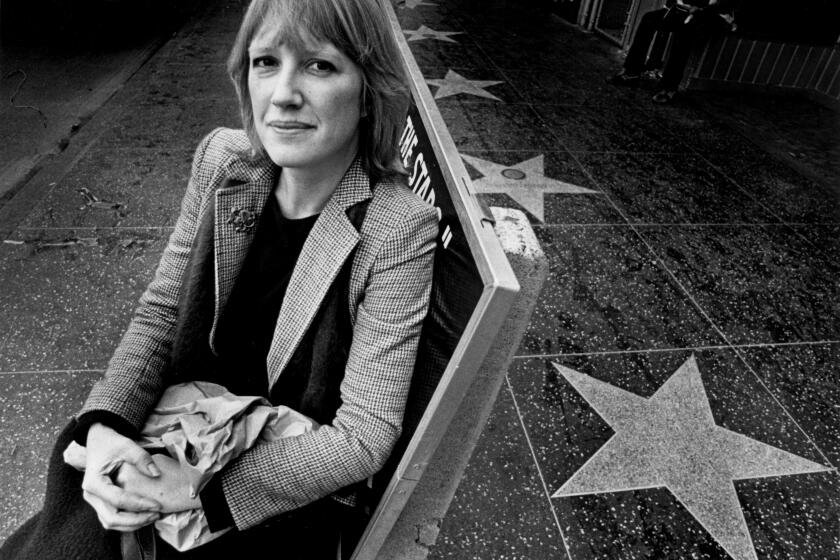‘Often imitated but rarely matched’: Writers reflect on Joan Didion’s impact
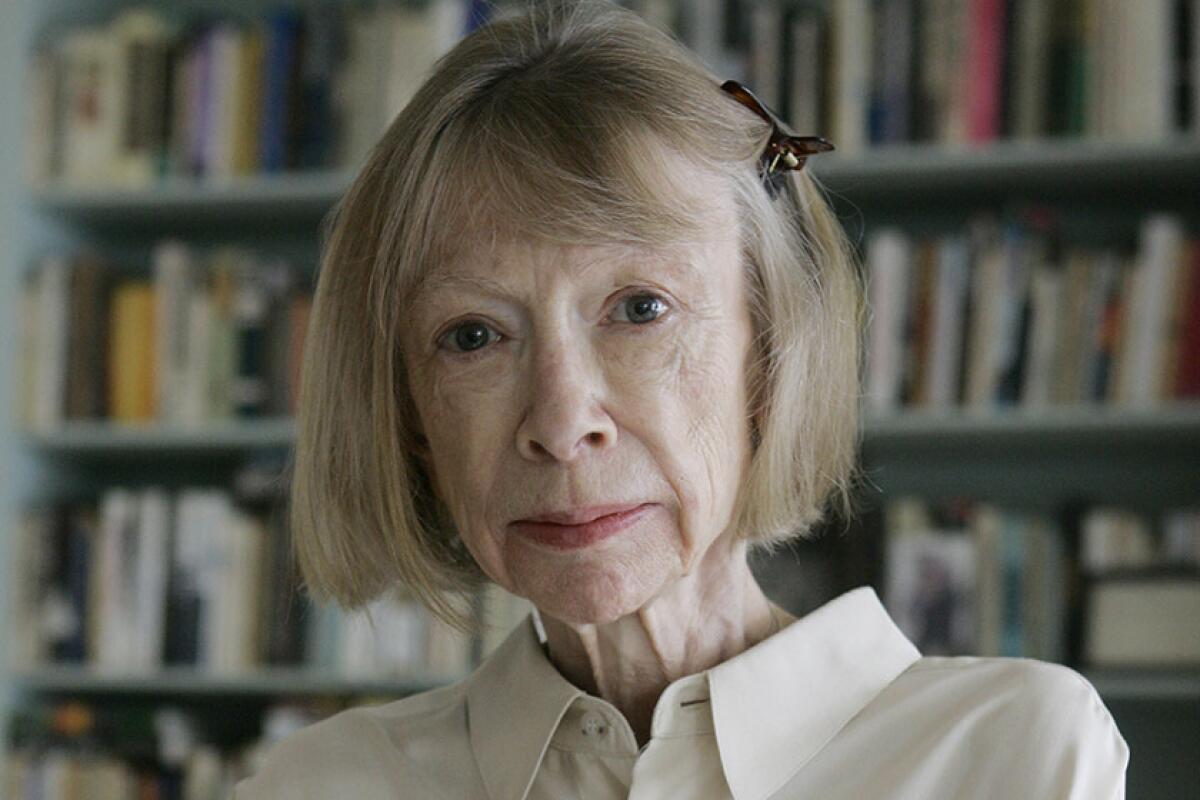
- Share via
When Matthew Specktor decided to start writing in earnest as a college sophomore, Joan Didion was on his mind.
Specktor, who grew up a few blocks from Didion’s Santa Monica home in the early 1980s, wanted to write about Los Angeles too, and he understood that Didion not only offered historical context — she was historical context.
“She set me back 10 years, because I had to write about this place in ways that she hadn’t,” he said.
“It’s a bit like what some writers have with William Faulkner, where when a writer comes along and describes a place so forcefully, you have to figure out what on earth you have to add to this conversation that hasn’t already been said.”
Didion died on Thursday due to complications from Parkinson’s disease at age 87 in her New York home. But she still belonged to California.
Didion bridged the world of Hollywood, journalism and literature in a career that arced most brilliantly in the realms of social criticism and memoir.
Writers in Los Angeles were crushed by the news but gratefully indebted to a woman whose keen observations and crystalline sentences inspired them to put pen to paper. To many who were then new to either California or the craft of writing or both, Didion was the first writer pressed into their hands, the perfect primer and inspiration for capturing a bewildering state — physical, mental and cultural. Even those who didn’t immediately warm to her defined themselves in relation to her and later acknowledged her greatness.
Didion wrote 19 books, including the novels “Play It As It Lays” and “A Book of Common Prayer.” Her two essay collections on the 1960s, “Slouching Towards Bethlehem” and “The White Album,” are considered canonical studies of America’s cultural revolution, while her memoirs, “The Year of Magical Thinking” and “Blue Nights,” redefined the contours of grief.
For the record:
11:52 a.m. Dec. 26, 2021An earlier version of this story misspelled the name of Shelley Wanger, Didion’s editor at Knopf.
Shelley Wanger, Didion’s editor at Knopf, called her “a brilliant observer and listener, a wise and subtle teller of truths about our present and future. She was fierce and fearless in her reporting. Her writing is timeless and powerful, and her prose has influenced millions.”
Perhaps nowhere is that truer than in the Golden State, where writers have sought to capture the depths and nuances of its sprawling cities like Los Angeles.
“I think she became a reference in writing about California,” said essayist and novelist Laila Lalami. “Regardless of how people felt about her or her writing, you couldn’t write about California without somebody telling you, ‘Have you read Joan Didion?’”
Lalami discovered Didion’s work as a foreign student in L.A. in the early 1990s. As a new arrival struggling to understand California, she was recommended Didion’s revelatory 1968 essay collection, “Slouching Towards Bethlehem”; she quickly followed that with the rest of Didion’s writing on the state.
Joan Didion continues to resonate in California, even with a generation nothing like her.
“For somebody like me, who’s an immigrant, it really helped me make sense of the political history of the place,” Lalami said.
For Carribean Fragoza, Didion’s ’60s essays were the first she read “that were really trying to capture or to feel intimately the vibe of what it meant to be here.”
She would move on to other writers but Didion “was one of the first that I happened to be introduced to,” said Fragoza, whose acclaimed short-story collection “Eat the Mouth That Feeds You” was released earlier this year.
Novelist and critic Scott Bradfield credited Didion for breaking free of the tendency to box California into detective fiction or derisive satire.
“She was somebody who wrote about California for Californians and for people outside of California, all at the same time,” he said. “She helped make the state a place that was considered a serious place to be a writer in.”
Tom Lutz, founder of the Los Angeles Review of Books, said Didion “made journalism glamorous and dangerous and personal, and she made the West Coast central to the country’s sense of where we were headed (Bethlehem or otherwise).”
David L. Ulin, who edited the Library of America’s three-volume Didion anthology, sees her signature melding of personal and collective stories as a key part of her legacy.
“She’s writing about these larger sort of cultural events or cultural shifts or cultural movements — always through her own point of view but always kind of looking outward from her individual sensibility to the broader collective sensibility,” he said.
“Didion captured the complexities and identity crises of the 20th century, all while never flinching in the face of the painful, the difficult, the absurd, the macabre,” said Ayad Akhtar, author and president of PEN America, in a statement. “All of us who practice the craft owe her an enormous debt.”
Inspired by her elegant, restrained and electric style, many tried to emulate her sharp descriptions of time and place but, as Mary Rasenberger, CEO of the Authors Guild, said in a statement: “She was often imitated but rarely matched.”
Writers like David Kipen have certainly tried.
“I still write too many of her patented hiccupping, chicken-bone sentences,” said the L.A.-based writer and founder of Boyle Heights’ Libros Schmibros. “I can’t help it. It’s that sentence with a chicken bone stuck in its throat, the one that interrupts itself — between dashes, commas, whatever — and then comes back around to shiv you in the ribs.”
Like Kipen, Steph Cha has worked to learn from Didion’s careful grammatical constructions, even for work in the genre of crime fiction (most recently “Your House Will Pay,” which won a Los Angeles Times Book Award).
“That’s a method that you can use to your heart’s content without feeling like you’re going to steal something because it’s just a technique,” said Cha. She also noted that translating experience into its most communicable essence will always be specific and unique to the writer.
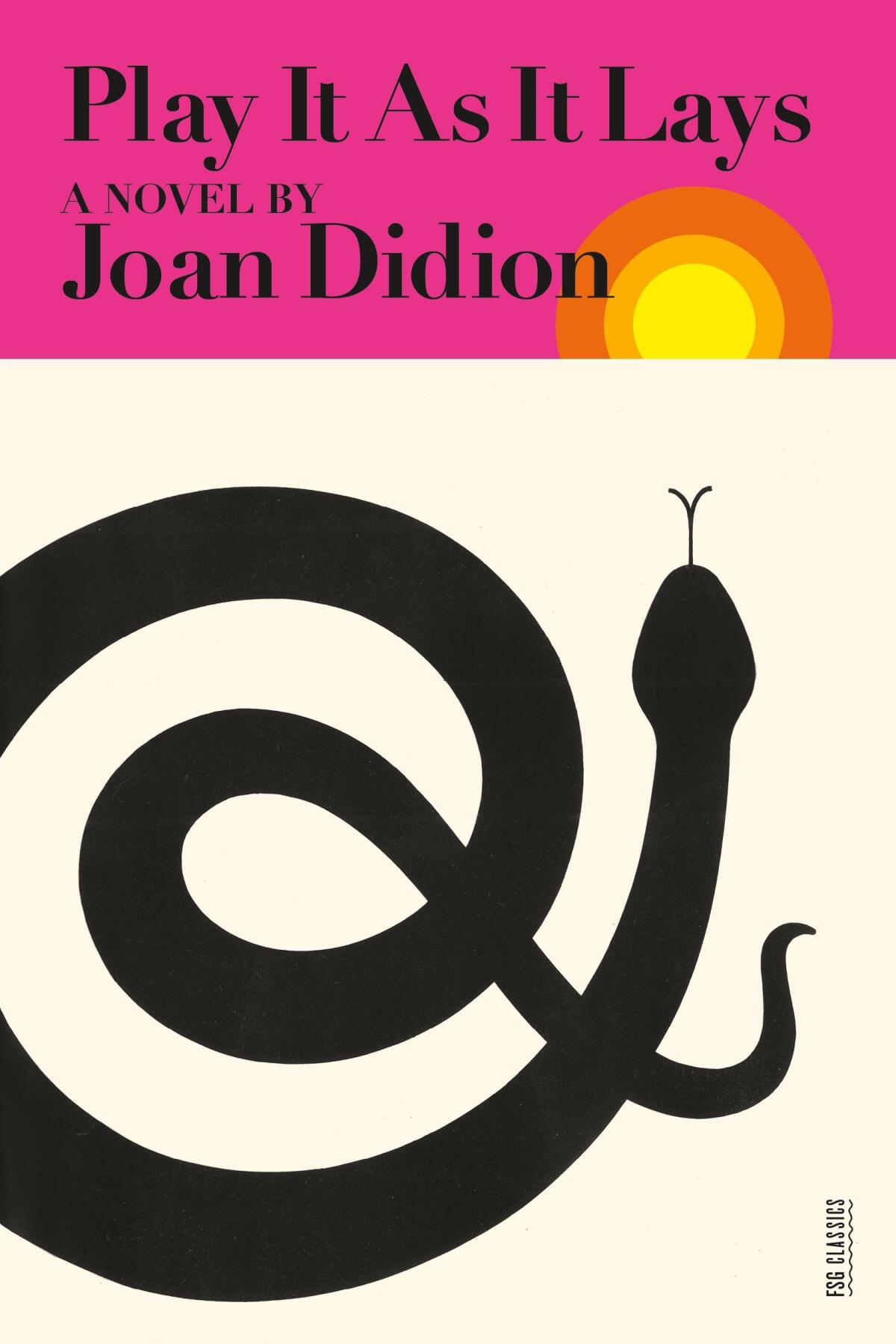
“She wrote beautiful, really structured paragraphs,” said Bradfield, citing Didion’s 1970s novel “Play It As it Lays” as especially powerful.
“I thought it was a brilliant way to write about L.A., because L.A. is so hard to piece stories in,” he said. “Everything is so disjointed and disconnected, but she would write about it in these powerful little scenes, these short, hard, compact scenes. … I remember that book really hitting me.”
As a young writer, Lalami studied Didion’s syntax, marking up books and copying lines into notebooks to try to understand how Didion deployed information — just as the young Didion once typed out entire stories by Ernest Hemingway to learn his style.
“With Joan Didion, you’re underlining something on every page because she’s so good,” Lalami said with a laugh.
Lynell George couldn’t remember a time when Didion’s writing wasn’t in her life. “It’s funny. … It’s almost like she’s always been in the backspace for me as a reader,” the Los Angeles-bred writer said.
She vividly remembered poring over a Xeroxed copy of the 1966 essay “Some Dreamers of the Golden Dream” as a new staff writer at L.A. Weekly in her mid-20s, sitting with another Weekly writer who had taught the essay in a college course.
“We ended up having this conversation about it as journalists starting out, taking it apart and looking at the layers of history, personal history and history of the region, and how she was reporting,” George recalled.
Working on long-form narrative pieces at the alt-weekly, George would sometimes reach for her copies of “Slouching Towards Bethlehem” or “The White Album.” Revisiting Didion’s work helped remind her to “think big and small” — to search for the crystalline details while also holding the larger story.
The author, who died Thursday, produced decades’ worth of memorable work. Here’s our guide to starting — or continuing — your Didion journey.
“Her writing is so electrifying, so powerful, that for writers, every new work of hers was like a national event,” said novelist and biographer Roxana Robinson.
“Just as people remember exactly where they were when men landed on the moon, writers remember the first time they read ‘The White Album’ ... or entered the bare, beautiful landscape of her novel ‘Play it As It Lays,’” she said. “Passages in Didion’s work have become burned into our consciousness.”
For others, Didion’s work was a tough sell at first.
Her “aloofness, her cold and unsentimental prose,” was a challenge to writer and editor Sophia Stewart as a college student at UC Berkeley, when — after learning Didion was a Berkeley alum — she checked out an armful of her books from the campus library.
“I still wrestle with it, as these are not characteristics of my own writing style, or even what I tend to read,” she said. “But it’s become one of the aspects of her work that I admire most. How she kept us at such a distance and was still able to hold us by the throat. No one does that like her.”
Lili Anolik‘s relationship with Didion was a bit more complicated — or, as she described it, “adversarial by proxy,” because she wrote “Hollywood’s Eve: Eve Babitz and the Secret History of L.A.” about a city chronicler who defined herself in opposition to Didion.
Anolik was sure to clarify that Babitz and Didion were friends; it was Didion who got Babitz published in Rolling Stone in 1972. “But the way Joan wrote about L.A. in ‘Play It As It Lays’ made Eve see red.
Eve Babitz, who chronicled life in Los Angeles with a hedonistic zeal drawing from lived experience, found her truest literary fame late in life.
“Joan’s L.A. was a 20th century Sodom and Gomorrah, whereas Eve’s L.A. was pure pleasure principle. If Eve had a problem with Joan, I had a problem with Joan.”
Still, Anolik conceded that her imagined rival was the greatest American stylist since Hemingway. “And has anyone ever looked better in sunglasses?” she added.
Didion’s influence also lay in the persona she had staked out in the world — as a woman with an unshakably strong personal perspective in what Fragoza called a “very masculine writer’s world.”
“I really took that to heart — that sort of position and that attitude — which I know has been criticized by others as being a very specifically white, sort of gringa attitude,” Fragoza said. “But I don’t think she ever hid that.”
“Her writing is [from] a very white and very privileged positionality,” Fragoza added. “But I think that when that is understood and when you take what is valuable to you ... it’s also very empowering.”
Stewart was careful not to call her “an outspoken feminist” but commended Didion for blazing the trail of New Journalism. “I think she created a new blueprint for what a woman writer could be and do, and for a lot of young women writers, she’s a lodestar.”
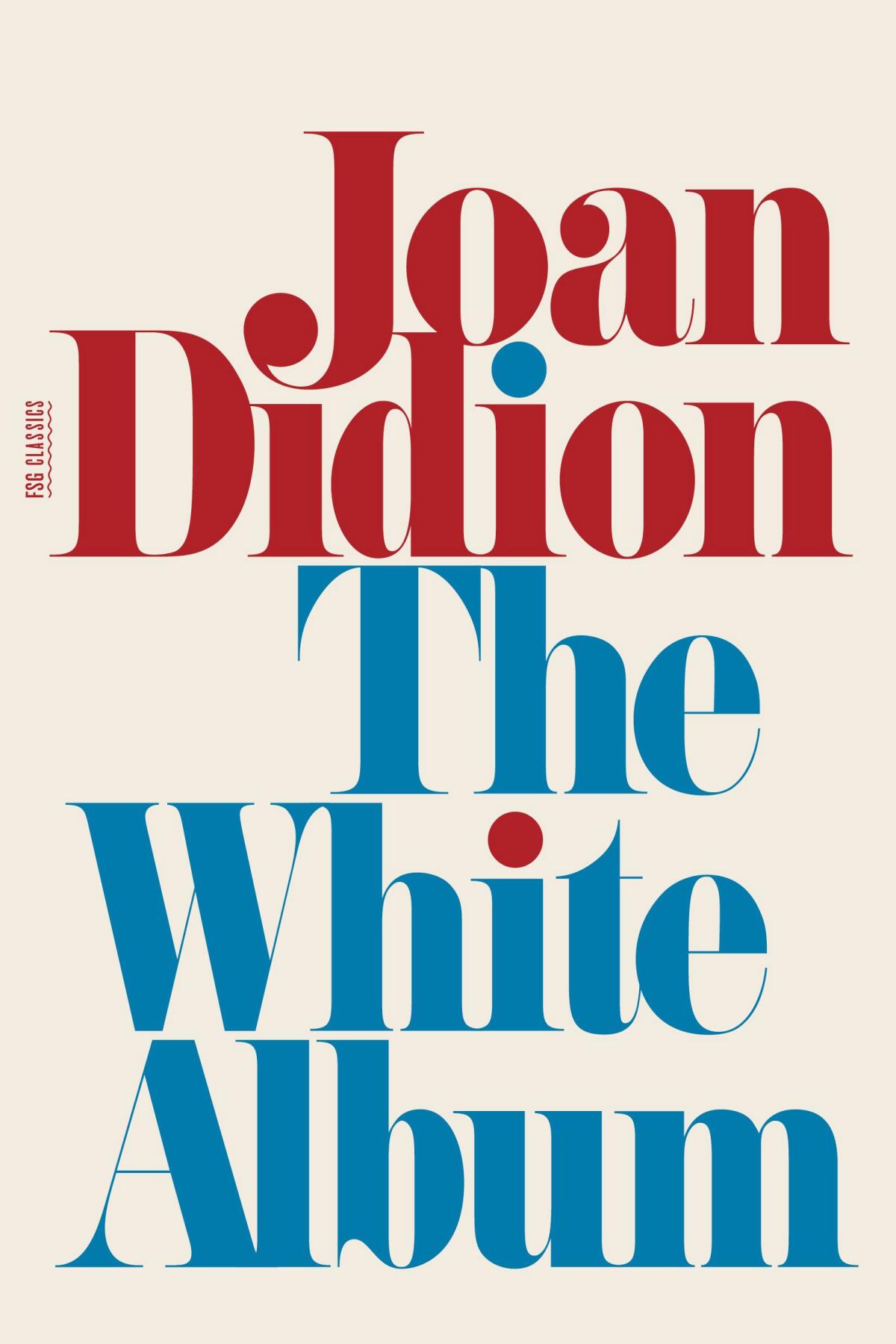
That’s certainly what Didion was to Specktor’s mother, Katherine, a screenwriter who grew up in the 1950s and was frustrated in her real ambition to be a novelist. Didion “rendered my mother enough permission to write at all.”
He recalled the time as a teenager when his mother handed him a clip of “Why I Write,” his first foray into Didion’s writing.
“What I didn’t understand until much later was that she was trying to explain something of herself to me,” he said. “These were radical and necessary sentiments that as a teenage boy I couldn’t begin to understand.”
Thinking back to his mother, Specktor believes that might be Didion’s greatest legacy. “I think so much of what her writing did was on behalf of women.”
Lutz echoed that sentiment. “As a woman who commanded the attention of the intelligentsia as well as the mass-market magazines based on pure talent, skill, perceptiveness, and smarts, she was our Simone de Beauvoir — an icon of tenacity, self-determination and achievement,” he said.
But for Kipen, Didion’s words were an expression of perpetual grief.
“Everything Didion wrote was an elegy,” he said. For the multiple versions of California she came to know through the years, for New York and the 1960s, and later for “a dignified American politics, for a sane foreign policy — and, finally, for her family.
“She borrowed the title ‘Goodbye to All That’ from Robert Graves, but she was never not saying goodbye,” he added. “Now we’re all saying it. That, and thanks.”
Ava DuVernay, Roxane Gay, Jessica Chastain and Gov. Gavin Newsom are among admirers paying tribute to writer Joan Didion, who died Thursday at age 87.
More to Read
Sign up for our Book Club newsletter
Get the latest news, events and more from the Los Angeles Times Book Club, and help us get L.A. reading and talking.
You may occasionally receive promotional content from the Los Angeles Times.
